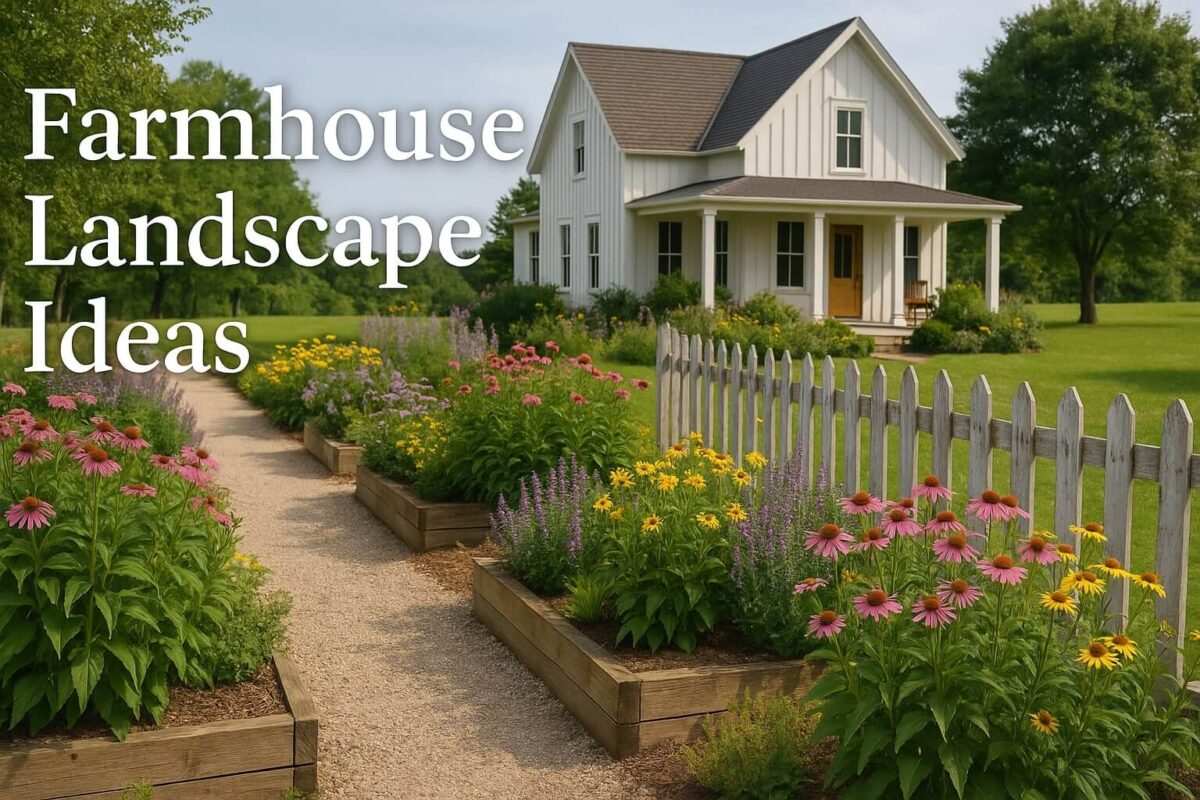There’s something deeply grounding about farmhouse landscape ideas that work with the land, not against it. They don’t shout for attention, they whisper stories. Of wildflowers drifting in the breeze, of gravel paths winding toward a weathered porch, of raised garden beds tucked beside a picket fence. Whether your farmhouse is nestled on rolling acres or simply styled that way in suburbia, the secret to making your outdoor space feel genuinely connected lies in blending function, local ecology, and beauty in equal measure.
A true farmhouse garden is more than decoration, it’s an extension of the home’s rhythm. It starts with respect, for the soil, the seasons, the wind’s direction. You’ll notice how traditional farm landscapes seem to grow out of their surroundings rather than being plopped on top. There’s an earthy elegance to them. Nothing fussy, nothing wasteful. Just simple, hardworking elements arranged with quiet intention.
Start with the bones: the paths, the fences, the trees. Then build in the perennials, herbs, and edible patches that bring your garden to life year after year.
Build the backbone first
In farmhouse landscaping, the hardscape tells the story before a single plant is in the ground. Begin by outlining key pathways and edges. Crushed limestone or pea gravel walkways are a classic choice, not just for their rustic look, but for their permeability and affordability. These gravel paths not only complement a farmhouse’s natural look, they also drain well and are easy to repair. Edge them with reclaimed timber or local stone for that authentic old-world texture.
Fences serve both form and function. A simple post-and-rail fence, slightly weathered, can define garden zones while still letting the eye wander. Try placing a cedar picket gate where your path meets the driveway, then soften its outline with climbing roses or honeysuckle. These touches blend beauty with utility, just like a true farmhouse should.
Don’t forget seating. Whether it’s a bench beneath a shade tree, a pair of chairs facing the setting sun, or a low stone wall doubling as a perch during garden chores, every farmhouse garden should make space for moments of stillness.
Let plants reflect the seasons
When it comes to choosing plants, farmhouse landscape ideas shine brightest when they follow nature’s lead. Opt for native species or climate-adapted favorites that know how to thrive with what your land naturally offers. These choices won’t just save you water, they’ll invite in local wildlife, bees, butterflies, birds, that create the feeling of a place alive and humming.
Start close to the house with foundation plantings. Use dwarf boxwoods or evergreen shrubs for year-round structure, then mix in flowering bushes like hydrangeas or spirea to bring color without fuss. Let tall hollyhocks or foxgloves lean gently against porch rails, and scatter low perennials like lavender or catmint along the edges. These layers create a lush, full look without overcrowding.
Cottage-style borders pair especially well with farmhouse settings. Think meandering beds of pastel perennials, herbs tucked here and there, and gravel paths that snake through like storybook trails. Lavender, sage, black-eyed Susans, phlox, and salvia all offer big beauty without needing constant babysitting.
And because every real farmhouse once grew food, don’t shy away from mixing in edible beds. A small raised garden planted with kale, tomatoes, strawberries, and basil doesn’t just provide produce, it connects you to the land’s deeper rhythm. Border the beds with woven willow or short stone walls to echo traditional kitchen plots. Keep gravel or mulch underfoot to cut down on mud and mess.
Think long-term, act in layers
The best farmhouse landscape ideas don’t happen overnight. Like farming itself, they unfold season by season. Start by planting trees. These are your future shade, your future windbreaks, your anchors. Use evergreens like spruce or cedar along the property edges to soften winds and provide privacy. Add fruit trees near the house for spring blossoms and fall harvests.
Windbreaks are especially valuable if you’re on open land. Just a few well-placed rows of conifers, shrubs, and deciduous trees can significantly cut down winter drafts and summer winds. They also create natural habitat corridors, making your space not just a garden, but a sanctuary.
Once trees are in, layer in shrubs and perennials over time. You don’t need to do it all at once. In fact, spacing out your planting allows you to observe how the sun moves, where the soil drains well, and what your lifestyle really needs from the land.
Use mulch widely, around trees, in beds, under pathways. Not only does it reduce watering and weeding, it gives the entire landscape a neat, intentional appearance. And if you can, install a simple rain-harvest system using old galvanized barrels or stock tanks. That’s one of the oldest farmhouse tricks for conserving water and giving your plants the soft, chlorine-free drink they crave.
Honor your farmhouse’s roots, whether urban or rural
You don’t need a hundred acres to bring these farmhouse landscape ideas to life. Whether your home sits in the countryside or a quiet cul-de-sac, the principles still apply. Focus on structure first: stone borders, gravel paths, humble fences. Choose plants that speak to your region. Aim for low maintenance, not because you’re lazy, but because the best farmhouse landscapes were never meant to be manicured, they were meant to live alongside you.
Every element should serve a purpose: beauty, food, shade, shelter, or story. Let old materials find new uses. Let your edges be a little soft. Let the garden tell its tale in every season.
And above all, let it feel like home.

